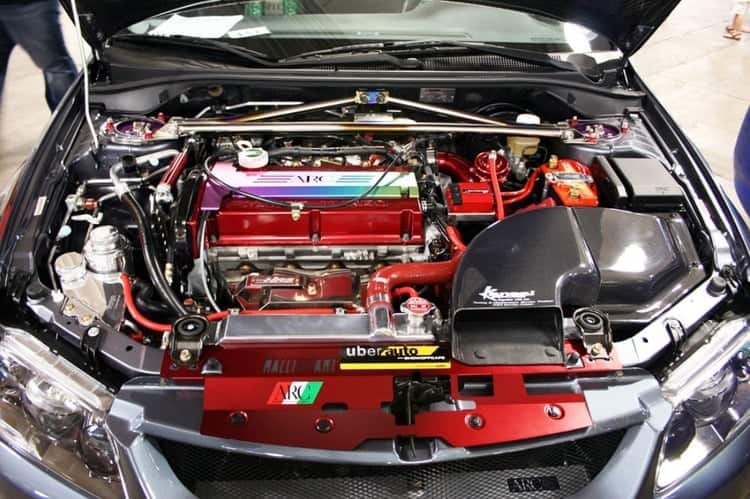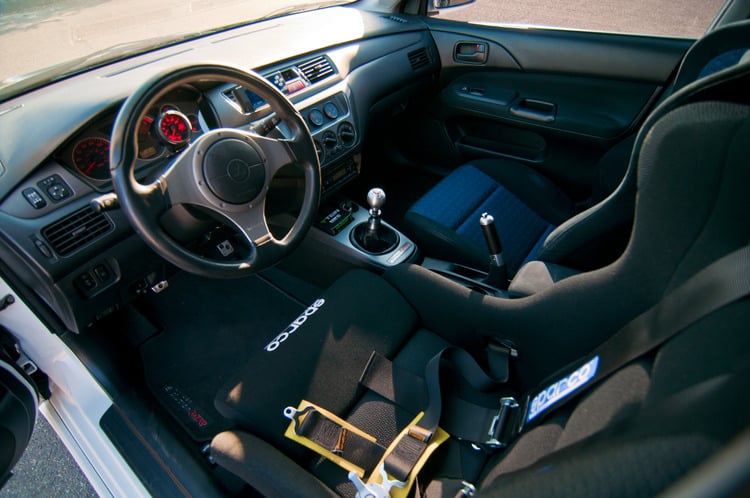Mitsubishi Evo 8 (VIII) – The JDM Supercar Killer?
The Evo 8 is one of the most tuner-friendly cars from Mitsubishi that can handle like it’s on rails but also has the potential ability to slide like crazy.

Jump To Section
Introduction
In 2003, the Japanese automobile manufacturer Mitsubishi introduced their quickest and most advanced Evolution. The car was known as the Lancer Evolution VIII and came equipped with cutting-edge technology such as Super Active Yaw Control (AYC).
Its performance was even more impressive than its predecessor, the Lancer Evolution VII. The enhanced performance primarily came from the AYC and other electrical components controlling the power distribution to all four wheels.
The Evo VI had previously marked the debut of the titanium/aluminide turbine wheel, but only in the stripped-down race-ready RS variant. Spool-up times were quicker thanks to less inertia, but these may not have been as hardy for road use as Mitsubishi expected since race engines are typically stripped down and overhauled after races.

The Evo VII was the first of a new breed of Evos not created as a homologation special for WRC purposes. This also proved to be the ‘friendliest’ of the Evo models then, especially for tuner heads.
The subsequent Evo VIII was just a styling exercise that didn’t see many revisions to the engine. It gained an extra cog (sixth) in GSR guise, though, and an MR variant became available.
The engine remained mostly intact from the Evo 7. However, some markets, especially the UK, started offering special pumped-up versions. In reality, the 405 horsepower limited production FQ400 was one of the most potent production cars ever sold in the UK.
Mitsubishi Evo History
In October 1992, the Lancer Evolution was first introduced. The 4G63-type intercooler turbo engine from Mitsubishi Motors was used to power the small and lightweight Lancer to produce impressive torque figures paired with its 4WD drivetrain.
Over the years, some substantial improvements took place with the engine, performance, increased body stiffness, weight reduction, suspension refinement, and enhanced aerodynamics, which resulted in the increased glory of the Mitsubishi Lancer Evolution.

Mitsubishi Motors Corporation launched the Evolution VIII sports sedan on January 31, 2003, in Japan. The launch marked Mitsubishi’s eighth enhancement made to the all-time favorite Evolution models since its launch in 1992.
Another interesting fact about the American community that owns Evo 8s is that they host the annual Mitsubishi Owners’ Day at the North American headquarters of Mitsubishi Motors. For the event, Mitsubishi drivers and supporters from all across the nation gather at one place in Cypress, California. The majority of the attendees are in clean, older 4G63t-powered vehicles.
Evo 8 Specifications
The Mitsubishi Lancer Evolution VIII entered production in 2003 and continued till 2005. The sleek and smart design had a curb weight of 1310-1410 kilograms, depending on the variant, and is powered by a 4G63t engine giving a very exciting power-to-weight ratio.
All variants had standard dimensions, a wheelbase of 2,625 mm, 4535 mm in length, 1770 mm in width, and 1450 mm in height.
The range-topping MR variants of the Evo VIII came with slick-response Bilstein shocks, significantly improving the vehicle’s handling.
Aluminum roof panels in this variant helped substantially reduce the car’s overall weight, making it even quicker and improving its road grip with a lowered center of gravity.

Mitsubishi made comprehensive improvements in its electronic four-wheel drivetrain with the introduction of Active Center Differential (ACD) and Super Active Yaw Control (AYC) traction control. The car also had sports Anti-lock braking systems.
Evo 8 Powertrain
The Evo 8 comes with a 2.0L, 4G63 Inline-four turbocharged engine, which generates 276 horsepower and 295 lb-ft of torque for the MR GSR variant and 405 horsepower 355 lb-ft of torque for the FQ-400 variant. These powertrains come paired with a 5-speed or 6-speed manual transmission.
The 4G63t is a sturdy little engine with great tuning potential. The bottom end of certain 4G engines, in particular, has some issues, but overall the engine is as dependable and long-lasting as any Japanese automobile of the era.

There is no reason a 4G63t powertrain shouldn’t endure more than 200,000 miles without requiring substantial repairs as long as a car is kept maintained and isn’t mistreated. The 4G63t is one of the earliest engines with a 4WD drivetrain in super-sedans to be made available in the United States.
It made its debut with the Mitsubishi Galant VR-4 in the US market. Due to its engine, it is a fantastic vehicle that, with a few modifications, can compete with the most recent Evo IX and other vehicles of its class. There aren’t many cars with an engine like this, which is why you want to find one.
Evo 8 Variants
Evo VIII came in a few different variants; the main classification was between the standard and MR models. The standard models had the RS 5-speed, RS 6-speed, and the GSR, which came with a 5-speed and an optional 6-speed transmission.
The MR models had the MR RS 5-speed, MR RS 6-speed, and the MR GSR, which came with 6-speed as standard.
The notable differences between the standard and MR models were that the latter came with some performance upgrades such as an Aluminium roof, carbon fiber spoiler, vortex generator, and some engine fixes!
The models made for the European and Japanese markets came loaded with high-tech features such as the Active Center Differential (ACD), Active Yaw Control (AYC), and titanium/aluminum wheels. These quirks were sadly not available in the models sold in the United States.

The 4G63t in this vehicle, the WRCo5 Lancer, is the ultimate model. Mitsubishi’s motorsport division, RALLIART, went all out for their final season of WRC Rally Racing. Some internal parts, block main girdle and dry sump oiling system, are among the few components not shared with the production engine; this was a race-only vehicle.
As mentioned earlier, the Evos sold in the United States were almost as good, but some high-tech features were missing.
For the first year at least, the AYC wasn’t available, along with the 6-speed gearbox and a limited-slip differential.
The engine was a brand-new 4G63t that had been significantly detuned for the US market because of the strict emission laws.
Despite those regulations, the engine still had impressive power figures, producing 271 horsepower and impressive torque figures of 273 ft-lbs.
The standard RS model went on sale in the USA in 2004. Mitsubishi introduced the MR variant with a 6-speed gearbox and an ACD for the 2005 model year, which produced 276 horsepower and 286 pound-feet of torque, which is the same rating as the Japanese variants.
Evo 8 Mods, Upgrades, and Tuning
Even a stock Evo 8 is a fun-to-drive car, but if you’re a car enthusiast, it won’t take long before the stock power numbers push you to do more since the car offers a wide variety of mods and upgrades.
Some mods with the car’s turbo are by far the quickest way to significantly increase the car’s power output.
Installing an aftermarket turbocharger can increase the power figures up to 500 horsepower.
Apart from oil and coolant, getting everything you need to finish your installation is simple with the MAP Complete Evo 8/9 T3 Turbo Kit!
Kelford TX272 camshafts serve as an excellent upgrade for the 4G63t engine. Further modifications include exhaust upgrades, intake upgrades, fuel pump upgrades, ignition system upgrades, and some clutch upgrades, such as adding a lightweight aluminum flywheel and stainless steel clutch fluid lines.
Common items like adjustable cam timing pulleys, aggressive camshafts, ported intake manifolds, engine management upgrades, and some other parts are also found under the hoods of some mildly modified street cars. Still, they require significantly more experience and work to install and tune.
On the other hand, maintenance of the fuel pump includes ensuring that it isn’t starving for fuel and that the injectors aren’t clogged. If in doubt, replace the former with a quality aftermarket replacement like the Walbro 190 lph pump, and send the latter to someone like Road/Race Engineering for a dip in the cleaning tank and a trip to the flow-equalizing bench.
Get a set of new stock plugs before tuning your engine. Use the OEM Iridium NGK’s in an Evo IXhead, and copper BPR8ES for everything else. Iridium plugs last a little longer, but copper plugs are also a good choice for a performance turbo engine.

The Evo intake system is very good, but that doesn’t mean it can’t be improved. A very nice carbon-fiber cold air intake from the Japanese tuner HKS Kansai is one of the best available. It draws in cold, high-pressure air from under the hood to make the turbo’s job easier.
The most common, cheapest, and easiest to replace exhaust systems are cat back types that replace the stock exhaust behind the catalytic converters. They’re popular because federal law prohibits modification or removal of existing catalytic converters, making cat-back exhausts the default choice for most people.
The 2g boost control solenoid (BCS) can be quickly modified for another 2.0 psi of boost by removing a restrictor on the output side of the solenoid.
The restrictor prevents the boost signal from dropping quickly, stops boost spikes in the stock boost control, and reduces the stock boost level.
A common upgrade is also a turbo timer. A turbo timer won’t help your engine make any more power, but it is helpful if you like to jump out of your car as soon as you park it.
Otherwise, wait a few seconds while the turbo spools down before shutting off the engine.
Some aftermarket turbos offer advantages you’ll never get from a bolt-on turbo, like surge ports on the compressor inlet.
These expand the turbo’s effective airflow range and make it more efficient during spool-up than a similar turbo without surge ports, so this is also a good upgrade.
If you are a movie buff you might remember the red EVO 8 from Tokyo Drift.
It was highly tuned example that was converted to rear wheel drive for the drifting scenes.
Evo 8 Reliability
There is a common misconception that all of these Mitsubishi cars are unreliable. However, this is probably due to inadequate maintenance availability rather than cheap build quality.
Perhaps the owners facing reliability issues with these cars do not properly know how to maintain these beasts.
The 4G63t engine suffers greatly if neglected and does not tolerate continued mistreatment. Timing belt replacement and oil changes are essential for the health of any turbocharged DOHC engine.
Some commonly known faults of the Evo 8 and the 4G63t engine include broken valves even with mileage as low as 60,000 miles.
This happens more often if the oil is not changed frequently enough, but they generally fail around 120K miles and produce smoke upon malfunctioning.
The most recent components provided by your nearby Mitsubishi dealer are of much-improved quality as opposed to the original seals and end up lasting longer.
The blue smoke from any turbo engine exhaust should be checked first.
Oil burning is a problem with high mileage engines, typically brought on by worn valve stem seals.
The head might require a tear-down or potential replacement but the wonderful thing about the valve stem seal is that its replacement is a reasonably simple task. Generally, the replacement of other worn components is a smart idea in the case of the 4G63t.
Owners must check for indications of oil in the coolant under the filling cap for the coolant. Since the cooling system is one of the weak points of the early vehicles, every vehicle with an unknown history should have the coolant changed.
The turbo might be another source of oil in the combustion chambers. Most 4G63t engines come equipped with a high-quality Mitsubishi turbocharger with a water-cooled center section.
With the right maintenance, which includes frequent oil changes, a turbo may run flawlessly for up to 150 000 miles, but if the engine’s maintenance is neglected, problems are inevitable.
A faulty turbo can emit smoke upon acceleration or, in the worst-case scenario, make a scraping sound when boost is applied.
Replacement of the turbo is suggested if it is causing the engine to burn a lot of oil.
Another cause of burning oil is worn rings. This problem is typically a result of higher miles on the engine. It comes up after around 200,000 miles or more.
If this problem arises, you will inevitably need to remove the engine and rebuild the bottom end.
It must be a general practice to check the compression before purchasing any turbocharged vehicle; it takes only a few seconds and will immediately indicate whether the engine is in a serviceable condition.
There are many additional issues that a compression test won’t detect, but it is a useful quick test for a bad motor. Nonetheless, you must avoid purchasing a faulty car unless it is affordable.
A car with a full set of service records is worth paying top cash for since the expense of neglect may increase quickly.
Conclusion
Buyers of 4G63t-powered vehicles tended to be those who intended to utilize them fully.
Therefore, if you don’t already own the legendary Evo 8 or want to expand your collection by having one, you’ll need a thorough search to discover a car that won’t explode when the boost is increased for the first time.
Before buying, you must look closely at the car’s appearance.
Generally, it appears tidy and well-kept, and there is a good chance that the car will also be mechanically sound.
You should also emphasize finding the straightest body because bodywork and upholstery are two of the most costly components of any automotive build.

The interior follows similar guidelines. Look for an uncluttered interior that is not overly worn.
Check the clutch and gas pedals to see whether the wear matches the mileage. Interior components for vintage automobiles are getting harder to locate as they age.
Try to obtain a solid sense of the general state of any possible project when you first look at it.
The final Lancer Evolution powered by a 4G63t made its debut in 2005. Though a few new variants were introduced, most of the vehicle was carried over from the previous generation.
The Mitsubishi Innovative Valve-timing Electronic Control (MIVEC), a device that alters valve timing on the engine’s intake side, was added to the 4G63t in its final incarnation.
This increased the engine’s range of usable power for driving. 286 horsepower and 289 ft-Lbs of torque were added to the ratings. The Evolution IX was sold as a station wagon in Japan but not in other countries.























